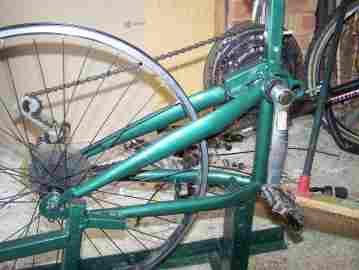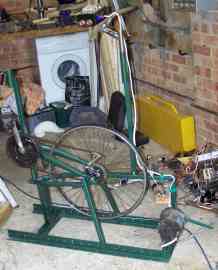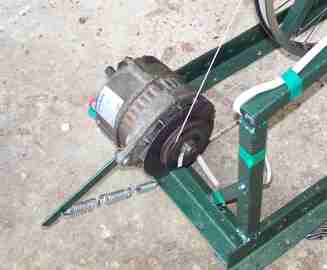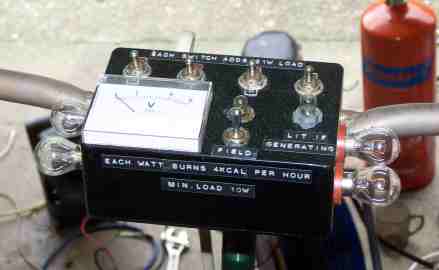A 12V Pedal-Powered Generator with Variable Loads for use as an Exercise Bike
This exercise bike was made from an old mountain bike (my brothers, which he had managed to almost totally destroy), an fairly standard alternator from a transit van, some scrap metal from a market stall and old racking. In normal use the alternator is belt driven from the wheel of the bike and the field current is supplied to the alternator from a 12V power brick. The original regulator was used to keep the output voltage constant and bank of four 21W light bulbs can be switched in to increase the load.
Due to the constant current drawn by the bulbs when run on the regulated output the load and hence the total energy dissipated is fixed for any given setting. This has the effect that pedalling faster reduces the amount of torque needed to turn the alternator and conversely as the person pedalling slows the alternator becomes harder to turn. This is quite counter-intuitive and takes some getting used to. knowing the rough efficiency of the alternator and the bike, and of the human body leads to the conclusion that for every Watt-hour dissipated by the bulbs 4 kilo-calories are burned.
The mechanical construction of the bike was quite simple - since the mountain bike used had rear suspension the back half of the bike just unbolted. This was turned upside down and mounted with the former rear wheel in front of the rider to maintain the correct direction of rotation. It was locked in the highest gear available and the tyre was removed so that a length of string could be run around the rim of the wheel as a drive-belt. This was welded onto a frame made from steel scrap. Two vertical posts were also added to this frame, one to hold the seat and the other to hold the handle bars and control box. These posts are bolted into place and can be detached in order to transport the finished exercise bike.
The alternator is mounted on one end of the frame and can pivot about that point. A lever is attached to the alternator and a pair of springs from that lever back to the frame serve to keep the drive-belt tight. A cable goes from the alternator to the control box. This Box allows the field current to be switched on and off so that the rider can build up speed before any load is applied. There are four other switches which each turn on one of the four 21W bulbs mounted on the sides of the box. These are the same bulbs commonly used in cars for brake lights, reversing lights, rear fog lights and indicators. Current to the field is supplied through a 5W bulb to limit it to less than half an amp and another 5W bulb is permanently wired across the alternator output to prevent voltage spikes which might damage the output diodes if operated with no load connected. The control box also includes two screw terminals to connect to external loads and a voltmeter which is more for encouragement than any real practical purpose - an ammeter might be more useful.
With all of the lights off the generator is fairly easy to pedal although some speed is needed. The only loads connected permanently are the 5W bulb on the control box and the field coils which take power from the alternator rather than the external power brick once the voltage is high enough - this can be seen by the field light, which is lit when field current is being drawn through it, going out when the alternator gets up to speed. It is possible start generating power without the external field current by bringing the alternator up to sufficiently high speed and making use of any residual magnetism however the sudden application of load as the field builds up causes the belt to slip somewhat. The exercise bike can be pedalled on even the highest settings by a reasonably fit person but this causes most people to tire very quickly. When all four lights are on it is very bright and it might be a good idea to add some kind of shield between them and the rider.



